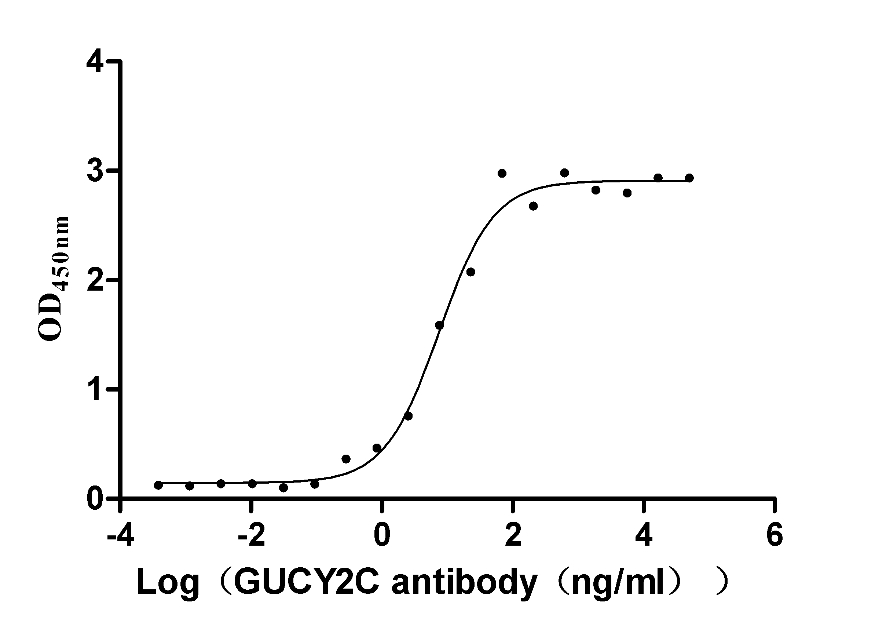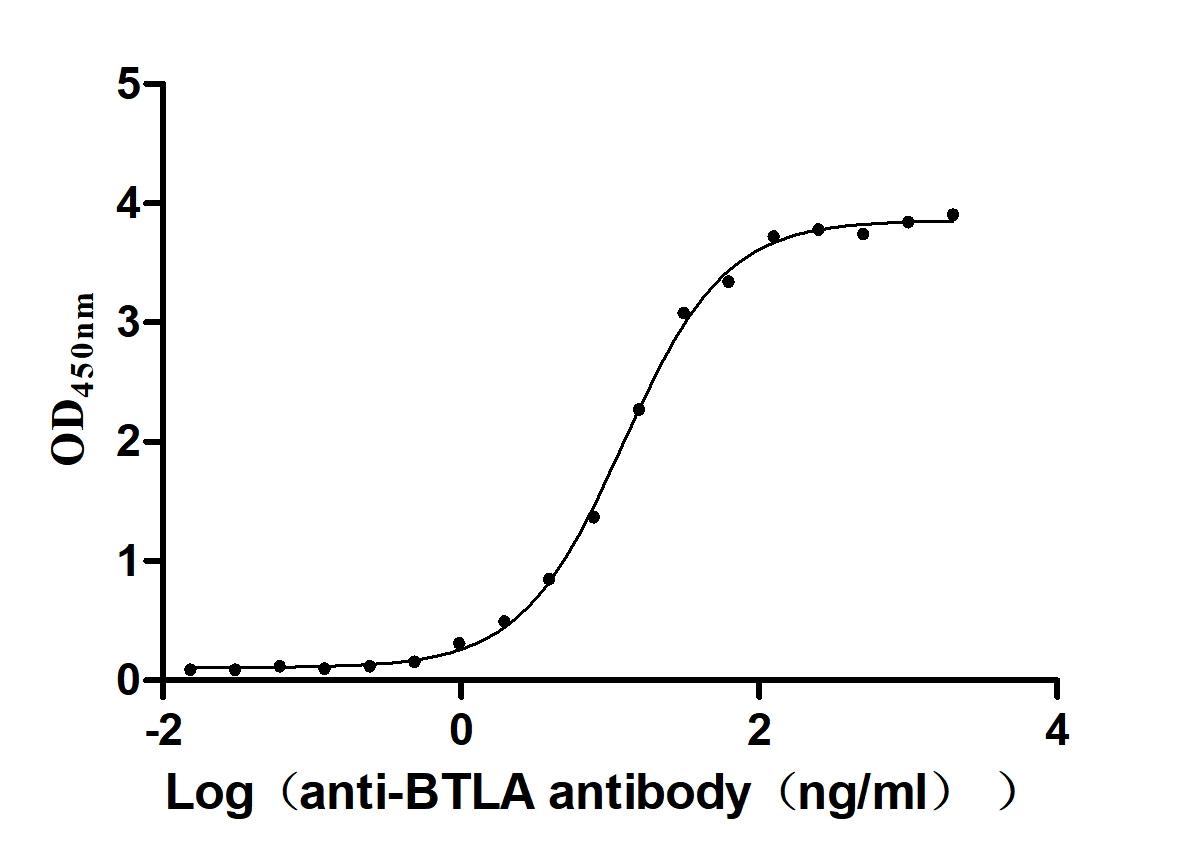Recombinant Rat Protachykinin-1 (Tac1)
-
中文名称:大鼠Tac1重组蛋白
-
货号:CSB-YP023062RA
-
规格:
-
来源:Yeast
-
其他:
-
中文名称:大鼠Tac1重组蛋白
-
货号:CSB-EP023062RA
-
规格:
-
来源:E.coli
-
其他:
-
中文名称:大鼠Tac1重组蛋白
-
货号:CSB-EP023062RA-B
-
规格:
-
来源:E.coli
-
共轭:Avi-tag Biotinylated
E. coli biotin ligase (BirA) is highly specific in covalently attaching biotin to the 15 amino acid AviTag peptide. This recombinant protein was biotinylated in vivo by AviTag-BirA technology, which method is BriA catalyzes amide linkage between the biotin and the specific lysine of the AviTag.
-
其他:
-
中文名称:大鼠Tac1重组蛋白
-
货号:CSB-BP023062RA
-
规格:
-
来源:Baculovirus
-
其他:
-
中文名称:大鼠Tac1重组蛋白
-
货号:CSB-MP023062RA
-
规格:
-
来源:Mammalian cell
-
其他:
产品详情
-
纯度:>85% (SDS-PAGE)
-
基因名:Tac1
-
Uniprot No.:
-
别名:Tac1; Nka; Nkna; Tac2; Protachykinin-1; PPT) [Cleaved into: Substance P; Neurokinin A; NKA; Neuromedin L; Substance K); Neuropeptide K; NPK); Neuropeptide gamma; C-terminal-flanking peptide]
-
种属:Rattus norvegicus (Rat)
-
蛋白长度:Cytoplasmic domain
-
表达区域:58-68
-
氨基酸序列RPK PQQFFGLM
-
蛋白标签:Tag type will be determined during the manufacturing process.
The tag type will be determined during production process. If you have specified tag type, please tell us and we will develop the specified tag preferentially. -
产品提供形式:Lyophilized powder
Note: We will preferentially ship the format that we have in stock, however, if you have any special requirement for the format, please remark your requirement when placing the order, we will prepare according to your demand. -
复溶:We recommend that this vial be briefly centrifuged prior to opening to bring the contents to the bottom. Please reconstitute protein in deionized sterile water to a concentration of 0.1-1.0 mg/mL.We recommend to add 5-50% of glycerol (final concentration) and aliquot for long-term storage at -20℃/-80℃. Our default final concentration of glycerol is 50%. Customers could use it as reference.
-
储存条件:Store at -20°C/-80°C upon receipt, aliquoting is necessary for mutiple use. Avoid repeated freeze-thaw cycles.
-
保质期:The shelf life is related to many factors, storage state, buffer ingredients, storage temperature and the stability of the protein itself.
Generally, the shelf life of liquid form is 6 months at -20°C/-80°C. The shelf life of lyophilized form is 12 months at -20°C/-80°C. -
货期:Delivery time may differ from different purchasing way or location, please kindly consult your local distributors for specific delivery time.Note: All of our proteins are default shipped with normal blue ice packs, if you request to ship with dry ice, please communicate with us in advance and extra fees will be charged.
-
注意事项:Repeated freezing and thawing is not recommended. Store working aliquots at 4°C for up to one week.
-
Datasheet :Please contact us to get it.
靶点详情
-
功能:Tachykinins are active peptides which excite neurons, evoke behavioral responses, are potent vasodilators and secretagogues, and contract (directly or indirectly) many smooth muscles.
-
基因功能参考文献:
- These findings reported here for the first time suggest an important role for a SP/NK1R system, either as genetic and/or epigenetic factor, in both the cytoplasm and nucleus functions of the adipose stem cells. PMID: 28500728
- Early and late behavioral changes in sciatic nerve injury may be modulated by nerve growth factor and substance P in rats PMID: 28685530
- Inferior alveolar nerve injury did not change the expression of GluA1, GluA2 and CGRP, but increased the expression of TRPV1 and substance P. PMID: 28337884
- The expression and distribution of SP and NK1R along the brain-gut axis in neonatal maternal separation rat. PMID: 27706667
- the present molecular and immunocytochemistry studies showed that there existed intrinsic substance P (SP) expression in the neurons of intrapancreatic ganglia, which constituted around half of SP origins in the pancreas suggesting that intrapancreatic ganglia might play an important role on mechanisms involving SP. PMID: 27431609
- The findings of this study suggested that there is an increased mobilization of SubP within processes in the RVM shortly after injury accompanied by an increased synthesis of SubP in neurons that project to the RVM. PMID: 26762802
- Tong Xie Yao Fang can modulate the activity of the enteric nervous system and alter 5-HT and SP activities, which may contribute to the symptoms of irritable bowel syndrome. PMID: 25914462
- rodent and non-human primate cardiac fibroblasts showed similar responses in genes that relate to ECM regulation and cell adhesion in response to SP. PMID: 25550118
- The spatial structures of human, mouse, and rat hemokinin-1 protein isoforms have been presented. PMID: 26349209
- Data demonstrate a role TAC1 in the control energy balance by regulating the levels of adiposity in response to ghrelin administration and to changes in the status of the gonadal function. PMID: 25751638
- The identification of Dex/forskolin response elements in the TAC1 promoter in amygdala neurones suggests a possible link in the chain of molecular events connecting GR activation and anxiety. PMID: 25001955
- Induction of diabetes leads to the increase of cell apoptosis and the decrease of substance P in the retina. PMID: 24045094
- Shugan-decoction can reduce chronic stress-induced visceral hypersensitivity in rats, and the regulatory mechanism may involve mediating the expression of substannce P in colon tissues. PMID: 24307802
- Villous subepithelial fibroblasts and afferent neurons interact via ATP and substance P. PMID: 23809436
- Sympathetic terminals in targets, in contrast to ganglion perikarya and processes, contain negligible quantities of SP. PMID: 24010178
- Downregulation of annexin A2 significantly inhibits divalent calcium ion influx and substance P mediated by TRPV4. PMID: 22762361
- Substance P is a pleiotropic early regulator of mRNA levels of key adhesiogenic mediators after surgery, suggesting that it may be a viable therapeutic target PMID: 22765994
- Studied effects of ultrafine titanium dioxide (UFTiO(2)) on the heart.Pulmonary exposure of rats to UFTiO(2) increased the phosphorylation levels of p38 MAPK and cardiac troponin I, but not Akt, in the heart and substance P synthesis in nodose ganglia. PMID: 21877901
- A TRPV1 mechanism mediates cardiac ischemia-induced release of substance P in the spinal cord. PMID: 22525132
- Substace P is implicated in the stimulation of neurogenesis and has the potential to promote recovery following traumatic brain injury. PMID: 22531375
- PACAP caused a concentration-dependent increase in the expression of the substance P precursor mRNA in a rat sensory neuronal cell line. PMID: 22418790
- Substance P is a potential anti-inflammatory modulator for the treatment of injury-induced inflammatory central nervous system disorders. PMID: 22825006
- Substance P, tyrosine hydroxylase and serotonin are not always co-localized in terminals forming inputs with laryngeal motoneurons; they arise from separate subpopulations of neurons. PMID: 21689789
- Both reactive oxygen species and substance P are involved in perinatal hypoxia-augmented, monocrotaline-induced pulmonary hypertension. PMID: 22559732
- PREP is not significantly responsible for the in vivo extracellular space cleavage of substance P or neurotensin. PMID: 21820035
- Data implicate USF1 as a major regulator of the action of lithium on the proximal preprotachykinin promoter. PMID: 20690045
- Substance P may be important in mediating adverse myocardial remodelling secondary to volume overload by activating cardiac mast cells, leading to increased TNF-alpha and MMP activation with subsequent degradation of the extracellular matrix. PMID: 21908647
- *esults show that the neurokinin 1 receptor mediates the role of substance P in learning and memory in the marginal division of the neostriatum. PMID: 21611833
- The cardioprotection role of substance P release in non-diabetic and diabetic rat hearts PMID: 21554904
- This study therefore assessed whether Substance P mediates edema formation in experimental subarachnoid hemorrhage PMID: 21377453
- Immunohistochemical studies showed a statistically significant reduction of SP in the bladders from the diabetic group compared with the control (P < 0.05). PMID: 20490673
- Substance P expression in masseter muscles increased following experimental occlusal interference. PMID: 20140043
- The expression of substance P and CGRP increased significantly in primary cultured DRG neurons in the presence of IGF-1. PMID: 20942583
- Data suggest that SP release from nerve fibers, lymphocytes and mast cells together with TNF-alpha can enhance the development of gastric inflammation and participate in tissue damage in gastritis. PMID: 20865295
- neuronal SP during bone regeneration has a stimulatory role on bone formation, while during remodeling increased SP fiber density in unloaded areas may be related to bone resorption. PMID: 20540103
- locomotor training activates mechanisms in a similar way to LTP, and is involved in the synaptic plasticity in the spinal cord. Such events appear not to be directly influenced by SP, suggesting a process that differs from those triggered by nociception. PMID: 20546710
- Data show that expression of substance P was observed in the dorsal root ganglion of the first lumbar vertebra. PMID: 20535049
- findings indicate that CB1 receptors facilitate substance P release by inhibiting the release of GABA and opioids next to primary afferent terminals, producing disinhibition; this results in a pronociceptive effect of CB1 receptors in the spinal cord PMID: 20074214
- Chronic prostatitis pain could upregulate the expressions of the excitatory transmitter SP and NK1 receptor in the L5-S2 spinal cord, which may be associated with the persistence and generalization of prostatitis pain. PMID: 20218316
- In repetitive strain injury, substance P immunoexpression increased in week 12 peritendon as did CTGF-immunopositive fibroblasts. PMID: 19743505
- Taken together, these findings indicate locally collateralizing glutamate neurons responsive to substance P contain VGLUT3. PMID: 19467322
- Substance p involved in vascular reactivity PMID: 11882578
- Involvement of the second extracellular loop (E2) of the neurokinin-1 receptor in the binding of substance P PMID: 11950831
- substance P may activate, via neurokinin-1 receptors, a hyperplastic but not hypertrophic response in adult cardiac fibroblasts PMID: 11959652
- melatonin may regulate tachykinin stores during aging mainly on structures of the neuroendocrine-reproductive axis PMID: 12084526
- Immunoreactive substance P is not part of the retinohypothalamic tract in the rat. PMID: 12172789
- Sensory nerve fibers containing substance P are distributed more abundantly in the superficial muscle layer of the dorsum than in the deeper layers and may be involved in the regulation of local blood flow. PMID: 12183023
- there is an increase of the releasable pool of substance P in the dorsal horn at late post-operative times after partial sciatic nerve ligation PMID: 12372698
- The increased levels of mRNA for substance P, the neurokinin-1 receptor, and the downstream mediators of substance P action in peritoneal tissue associated with intraabdominal adhesions support a role for substance P in adhesion formation. PMID: 12443729
- Substance P plays a role in proinflammatory cytokine-induced leakage of the blood-brain barrier. PMID: 12458035
显示更多
收起更多
-
亚细胞定位:Secreted.
-
蛋白家族:Tachykinin family
-
数据库链接:
KEGG: rno:24806
STRING: 10116.ENSRNOP00000009888
UniGene: Rn.1920
Most popular with customers
-
Recombinant Human Heat-stable enterotoxin receptor (GUCY2C), partial (Active)
Express system: Mammalian cell
Species: Homo sapiens (Human)
-
Recombinant Rat Intestinal-type alkaline phosphatase 1 (Alpi) (Active)
Express system: Mammalian cell
Species: Rattus norvegicus (Rat)
-
Recombinant Macaca fascicularis CD44 antigen (CD44), partial (Active)
Express system: Mammalian cell
Species: Macaca fascicularis (Crab-eating macaque) (Cynomolgus monkey)
-
Recombinant Human Complement component C1q receptor (CD93), partial (Active)
Express system: Mammalian cell
Species: Homo sapiens (Human)
-
Recombinant Macaca fascicularis zymogen granule protein 16 homolog B (ZG16B) (Active)
Express system: Mammalian cell
Species: Macaca fascicularis (Crab-eating macaque) (Cynomolgus monkey)
-
Recombinant Human CUB domain-containing protein 1 (CDCP1), partial (Active)
Express system: Mammalian cell
Species: Homo sapiens (Human)
-
Recombinant Human B- and T-lymphocyte attenuator(BTLA), partial (Active)
Express system: Mammalian cell
Species: Homo sapiens (Human)
-
Recombinant Macaca fascicularis Transmembrane 4 L6 family member 1 (TM4SF1)-VLPs (Active)
Express system: Mammalian cell
Species: Macaca fascicularis (Crab-eating macaque) (Cynomolgus monkey)




















